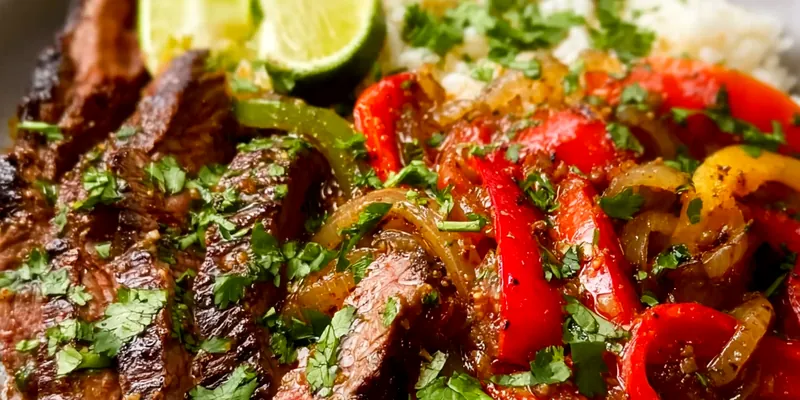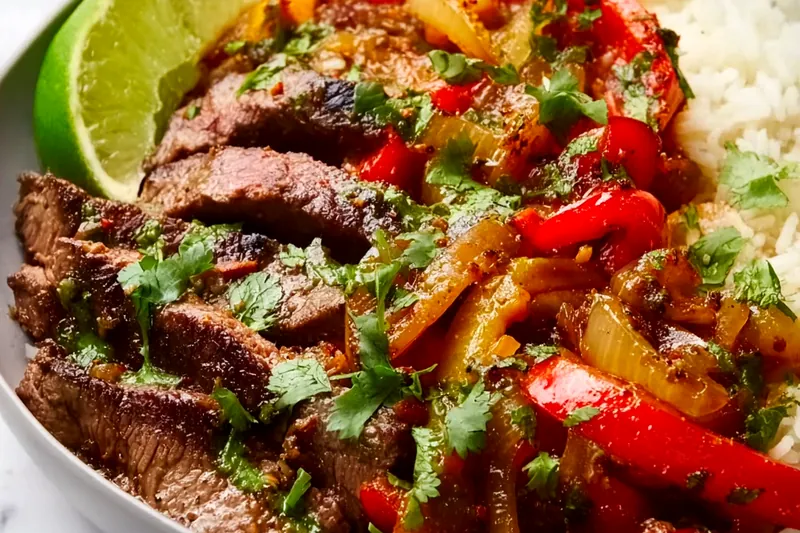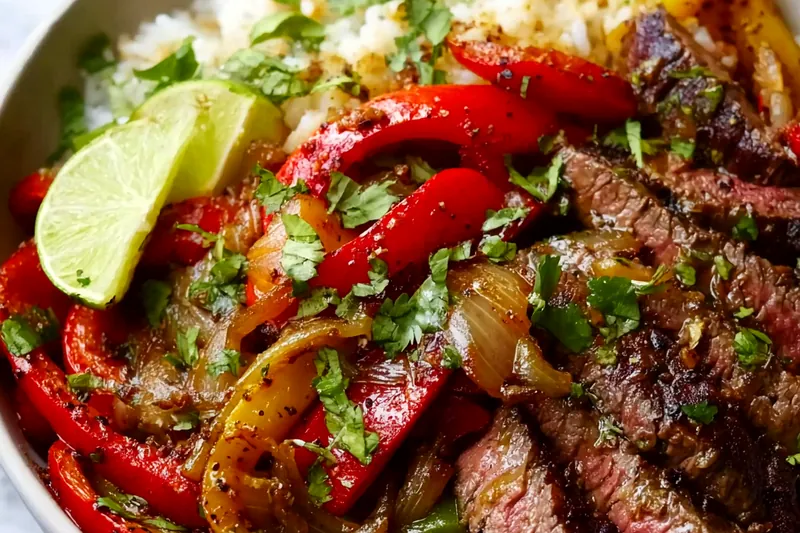High-Protein Steak Fajita Bowl
Protein-packed steak fajita bowl with tender marinated beef, colorful peppers, and nutritious toppings. Perfect for meal prep and healthy eating goals.

Maximizing Protein and Nutritional Value
This bowl delivers over 40 grams of complete protein from multiple sources including lean steak, black beans, Greek yogurt, and cheese. The combination provides all essential amino acids needed for muscle protein synthesis while keeping calories in check for those with fitness goals.
The marinade not only infuses incredible flavor but also helps tenderize the lean steak cuts. Acid from lime juice begins breaking down tough fibers while the spices add antioxidants and anti-inflammatory compounds that support recovery and overall health.
💡 Professional Tip
Slice the steak against the grain at a 45-degree angle for maximum tenderness. This shortens the muscle fibers and makes even lean cuts like flank steak incredibly tender and easy to chew.
Frequently Asked Questions
Absolutely! Cook all components and store separately. Combine everything except avocado when ready to eat. The bowls keep for 4-5 days in the refrigerator and are perfect for meal prep.
Flank steak, skirt steak, or sirloin work best. These lean cuts are high in protein, relatively affordable, and take well to marinades. Avoid expensive cuts like ribeye which are higher in fat.
Use cauliflower rice instead of quinoa and skip the black beans. You can add extra vegetables like zucchini, bell peppers, or leafy greens to maintain volume and nutrients.
Yes! Chicken breast or thighs work well with the same marinade. Adjust cooking time accordingly - chicken breast takes about 6-7 minutes per side depending on thickness.
You can substitute with sour cream (lower protein), cottage cheese (higher protein), or make a quick avocado crema. Greek yogurt provides the highest protein content.
For medium-rare, cook 2-3 minutes per side until internal temperature reaches 130-135°F. The steak should feel slightly firm but still give when pressed. Let it rest before slicing.
Skip the cheese and Greek yogurt, or use dairy-free alternatives. The bowl is still high in protein from the steak and beans. Add extra avocado for creaminess.
Try corn, jalapeños, pickled onions, hot sauce, or different nuts/seeds. For extra protein, add a hard-boiled egg or extra beans. Keep portions balanced for your goals.
Recipe Troubleshooting Guide
Tough or Chewy Steak
Problem: Steak turns out tough despite marinating
Solution: Always slice against the grain, don't overcook (medium-rare is ideal), and let it rest after cooking. Consider pounding the meat lightly before marinating for extra tenderness.
Dry Steak
Problem: Lean steak becomes dry during cooking
Solution: Don't overcook lean cuts - aim for medium-rare. Use high heat for quick searing, marinate adequately, and let rest before slicing to retain juices.
Vegetables Too Soft
Problem: Peppers and onions become mushy
Prevention: Cook over medium-high heat, don't overcrowd the pan, and aim for tender-crisp texture. They should retain some bite for better texture contrast in the bowl.
Uneven Cooking
Problem: Some pieces of steak cook faster than others
Recovery: Cut steak pieces uniformly, don't overcrowd the pan, and cook in batches if necessary. Use a heavy-bottomed pan for even heat distribution.
Bland Flavor
Problem: Final bowl lacks flavor depth
Prevention: Season each component properly, don't skip the marinade time, taste and adjust with lime juice and salt, and use fresh herbs generously.
Flavor Balance Issues
Too Sweet: Add more lime juice, hot sauce, or pickled jalapeños to balance sweetness from peppers
Too Salty: Balance with extra lime juice, fresh cilantro, or a touch of honey in the marinade
Bland: Increase spices in marinade, add hot sauce, use fresh lime juice, or finish with flaky sea salt

Selecting Quality Ingredients for Optimal Nutrition
Choosing the right cut of steak is crucial for both protein content and tenderness. Lean cuts like flank steak provide approximately 30 grams of protein per 4-ounce serving while remaining relatively low in saturated fat. Look for bright red color and minimal marbling for the leanest option.
Greek yogurt serves as both a healthy topping and protein booster, providing additional probiotics for gut health. Choose plain, full-fat Greek yogurt for the best texture and protein content - it contains nearly double the protein of regular yogurt while adding creamy richness to balance the bold flavors.
Essential Ingredient Notes
- Steak Selection: Choose grass-fed beef when possible for better nutrient profile. Flank steak should be deep red with minimal fat marbling. Freeze for 30 minutes before slicing for easier, more uniform cuts.
- Greek Yogurt Quality: Look for plain Greek yogurt with 15-20g protein per serving. Avoid flavored varieties with added sugars. Full-fat versions provide better satiety and flavor than low-fat options.
- Fresh Produce: Choose firm, brightly colored bell peppers and ripe but firm avocados. Fresh lime juice makes a significant difference over bottled - look for heavy, thin-skinned limes.

Cooking Techniques for Maximum Flavor and Nutrition
High-heat searing is essential for developing the Maillard reaction that creates deep, complex flavors while keeping the interior tender and juicy. The key is not moving the steak too early - let it develop a proper crust before flipping for optimal texture and taste.
Proper resting after cooking allows juices to redistribute throughout the meat, ensuring every bite is moist and flavorful. This step is crucial for lean cuts that can quickly become dry if rushed. The residual heat continues cooking the steak to the perfect doneness.
The Perfect Sear
Preheat your pan until it's smoking hot, then add the marinated steak in a single layer. Don't move it for 2-3 minutes to develop a beautiful crust, then flip once and repeat.
High-Protein Steak Fajita Bowl
📋 Ingredients
For the Marinated Steak
- 200g cooked quinoa or cauliflower riceChoose based on carb goals
- 400g black beans, drainedAdditional plant-based protein and fiber
- 2 medium avocados, slicedHealthy fats for satiety and flavor
- 120g plain Greek yogurtHigh-protein, probiotic-rich topping
- 150g cherry tomatoes, halvedFresh vitamins and bright acidity
- 60g Mexican cheese blendAdditional protein and calcium
- 30g pumpkin seeds (pepitas)Healthy fats, protein, and crunch
For the Bowl Assembly
- 680g flank steak, sliced thin against grainLean, high-protein main component
- 30ml olive oilBase for marinade and healthy fats
- 30ml fresh lime juiceTenderizes meat and adds bright flavor
- Mexican spice blendCumin, chili powder, paprika for authentic flavor
- 2 bell peppers, slicedVitamin C, fiber, and colorful nutrition
- 1 large onion, slicedAdds sweetness and savory depth
- Fresh cilantro and lime wedgesBright, fresh finishing touches
Instructions
Marinate the Steak
In a bowl, whisk together olive oil, lime juice, garlic, cumin, chili powder, paprika, oregano, salt, pepper, and cayenne. Add sliced steak and marinate for at least 15 minutes or up to 2 hours in refrigerator.
Prepare Base and Toppings
Cook quinoa according to package directions or prepare cauliflower rice. Rinse and drain black beans. Slice avocados, halve cherry tomatoes, and prep all other toppings. Set aside in separate bowls.
Cook Vegetables
Heat avocado oil in large skillet over medium-high heat. Add sliced peppers and onions. Cook 6-8 minutes until slightly charred and tender-crisp. Season with salt and pepper. Transfer to plate.
Sear the Steak
In same skillet, cook marinated steak over high heat for 2-3 minutes per side until nicely browned but still medium-rare to medium. Don't overcrowd - cook in batches if needed. Let rest 3 minutes.
Assemble Bowls
Divide quinoa or cauliflower rice among 4 bowls. Top each with sliced steak, fajita vegetables, black beans, avocado, tomatoes, Greek yogurt, cheese, salsa, cilantro, and pumpkin seeds. Serve with lime wedges.
Recipe Notes & Tips
Meal Prep Success
Store cooked steak, vegetables, and base separately from fresh toppings. Assemble bowls when ready to eat for best texture and freshness. Everything except avocado can be prepped 4-5 days ahead.
Customizing Macros
For higher protein, add an extra 2 oz of steak per bowl. For lower carbs, use cauliflower rice and skip beans. For higher healthy fats, add extra avocado or nuts/seeds.
Flavor Variations
Try different marinades like chimichurri or adobo. Swap Greek yogurt for avocado crema. Add pickled jalapeños, corn, or different types of salsa to keep meals interesting throughout the week.
